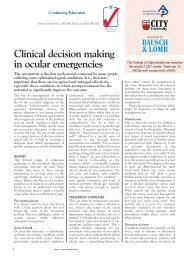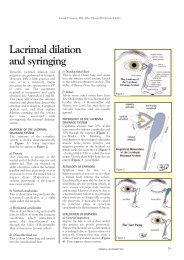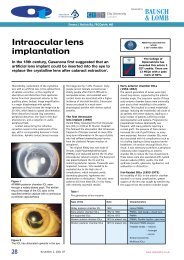Download the PDF
Download the PDF
Download the PDF
Create successful ePaper yourself
Turn your PDF publications into a flip-book with our unique Google optimized e-Paper software.
CET<br />
CONTINUING<br />
EDUCATION &<br />
TRAINING<br />
THIS ISSUE CET: FREE<br />
✔<br />
✔<br />
Approved for Optometrists Approved for DOs<br />
To gain more standard CET points for this year’s PAYL series, purchase your credits at<br />
www.otbookshop.co.uk and <strong>the</strong>n enter online at: www.otcet.co.uk to take your exams<br />
✘<br />
Sponsored by:<br />
aetiology is determined, <strong>the</strong>n resolution<br />
is expected to occur in approximately<br />
two to four months. In an acute pupil<br />
sparing third nerve palsy, <strong>the</strong> patient<br />
must be watched closely over <strong>the</strong><br />
following days to monitor for pupil<br />
involvement. Secondary aberrant<br />
regeneration (upper lid elevation on<br />
attempted downgaze) never occurs in<br />
microvascular cranial nerve palsy and<br />
neuro-radiological imaging must be<br />
obtained. If <strong>the</strong> nerve palsy is not<br />
isolated, or progressive, or o<strong>the</strong>r palsies<br />
are sequentially involved, <strong>the</strong>n<br />
microvascular aetiology is unlikely.<br />
The age of <strong>the</strong> patient is also important<br />
and if <strong>the</strong> palsy occurs in a young age<br />
group, a microvascular aetiology is<br />
again unlikely. Lastly, diplopia is a<br />
common symptom of Giant Cell<br />
Arteritis and must be considered in<br />
anyone over <strong>the</strong> age of 50 years.<br />
Accommodation and Pupils<br />
Reduced amplitude of accommodation<br />
can be a result of diabetic eye disease.<br />
This can occur as a complication of<br />
panretinal photocoagulation for<br />
proliferative diabetic retinopathy. This<br />
can ei<strong>the</strong>r be temporary or permanent.<br />
The prevalence is unknown but it is<br />
likely to be under reported. The<br />
complication is thought to arise as a<br />
result of <strong>the</strong>rmal injury to <strong>the</strong> short<br />
ciliary nerve, causing parasympa<strong>the</strong>tic<br />
denervation of <strong>the</strong> ciliary muscle. 109<br />
Pupillary involvement in DM has<br />
similarities with Adie’s tonic pupil. A<br />
tonic pupil responds to both light and<br />
near stimuli, but constriction and redilation<br />
is very slow. This is thought to<br />
< Figure 6<br />
Anterior ischaemic optic neuropathy<br />
be due to denervation hypersensitivity.<br />
The segmental denervation (vermiform<br />
movements) observed in Adie’s pupil,<br />
is not present in tonic pupils secondary<br />
to diabetes.<br />
Anterior Ischaemic Optic<br />
Neuropathy (AION)<br />
AION is an ischaemic infarction of <strong>the</strong><br />
anterior portion of <strong>the</strong> optic nerve,<br />
secondary to occlusion of <strong>the</strong> short<br />
posterior ciliary arteries (Figure 6).<br />
There are two forms – arteritic (A-<br />
AION) and non-arteritic (NA-AION).<br />
The former is caused by Giant Cell<br />
Arteritis, an inflammatory vascular<br />
condition that requires prompt<br />
recognition and treatment if visual loss<br />
is to be prevented. The latter is thought<br />
to occur ei<strong>the</strong>r because of transient non<br />
or hypoperfusion of <strong>the</strong> optic nerve<br />
head or an embolic lesion of <strong>the</strong><br />
arteries/arterioles feeding <strong>the</strong> nerve<br />
head. Studies suggest that up to 25% of<br />
patients with NA-AION have a history<br />
of diabetes. 110 In a person with a<br />
predisposing risk factor such as<br />
diabetes, <strong>the</strong> precipitating element is<br />
typically nocturnal arterial hypotension<br />
(<strong>the</strong>se patients usually wake in <strong>the</strong><br />
morning to discover <strong>the</strong>ir visual loss). 111<br />
Ocular risk factors include an absent or<br />
small cup in <strong>the</strong> optic disc, angle<br />
closure glaucoma or o<strong>the</strong>r causes of<br />
markedly raised IOP. In contrast to<br />
visual acuity, which can sometimes be<br />
within normal limits in almost half of<br />
<strong>the</strong> eyes with NA-AION, visual field<br />
defects are universal, <strong>the</strong> most common<br />
being an altitudinal defect.<br />
Fundoscopy usually reveals swelling of<br />
<strong>the</strong> optic disc (occasionally just in one<br />
segment), prominent, dilated vessels<br />
over <strong>the</strong> disc and peripapillary<br />
haemorrhages. The fellow eye may<br />
become involved in a significant<br />
number of cases.<br />
There is no proven treatment for NA-<br />
AION. In one study, patients were seen<br />
within two weeks of <strong>the</strong> onset of visual<br />
loss, with initial visual acuity of 20/70<br />
or worse and an improvement was<br />
reported in 41–43% and<br />
a worsening in 15–19% at six months. 112<br />
Diabetic papillopathy is sometimes<br />
considered a form of atypical<br />
NA-AION. Typical findings include a<br />
swollen, hyperaemic optic disc and<br />
peripapillary capillary dilatation. An<br />
important differentiation to make is<br />
firstly, papilloedema and secondly,<br />
neovascularisation of <strong>the</strong> optic disc.<br />
Syndromes<br />
Wolfram syndrome, a genetic condition<br />
possibly of autosomal recessive<br />
inheritance, is associated with juvenile<br />
onset DM and optic atrophy. The<br />
syndrome is also known as DIDMOAD<br />
(Diabetes Insipidus, Diabetes Mellitus,<br />
Optic Atrophy, and Deafness). 113 In<br />
most cases, DM and optic nerve<br />
atrophy are seen in <strong>the</strong> first and second<br />
decades, between <strong>the</strong> ages of 2–15 and<br />
4–18 years, respectively. 114 In 12 UK<br />
families with Wolfram syndrome,<br />
genetic linkage to <strong>the</strong> short arm of<br />
chromosome 4 was confirmed. 115 Optic<br />
atrophy which results from a<br />
permanent loss of ganglion cells has<br />
also been reported as a direct<br />
consequence of diabetic ketoacidosis. 116<br />
Alstrom syndrome, ano<strong>the</strong>r rare<br />
genetic condition should be suspected<br />
in a child with a retinal dystrophy,<br />
particularly if <strong>the</strong>ir weight is above <strong>the</strong><br />
90th percentile. The condition is<br />
progressive with no perception of light<br />
by <strong>the</strong> age of 20 years. The diagnosis of<br />
DM often occurs in <strong>the</strong> second or even<br />
third decade of life. 117<br />
Conclusion<br />
This article is not a comprehensive<br />
review but, apart from <strong>the</strong> obvious<br />
diabetic retinopathy, provides an<br />
overview of <strong>the</strong> range of ocular<br />
pathologies that are associated with<br />
DM. Optometrists are advised to be<br />
familiar with <strong>the</strong> possible<br />
presentations, a number of which are<br />
ocular emergencies that require urgent<br />
medical investigation and treatment.<br />
About <strong>the</strong> author<br />
Shaheen P Shah MRCOphth MSc is an<br />
Ophthalmic Specialist Registrar (SpR)<br />
in <strong>the</strong> London Deanery and an<br />
Honorary Clinical Lecturer at <strong>the</strong><br />
International Centre for Eye Health.<br />
Figures courtesy of Professor Susan<br />
Lightman<br />
References<br />
See www.optometry.co.uk/references<br />
31<br />
08/05/09 CET
















